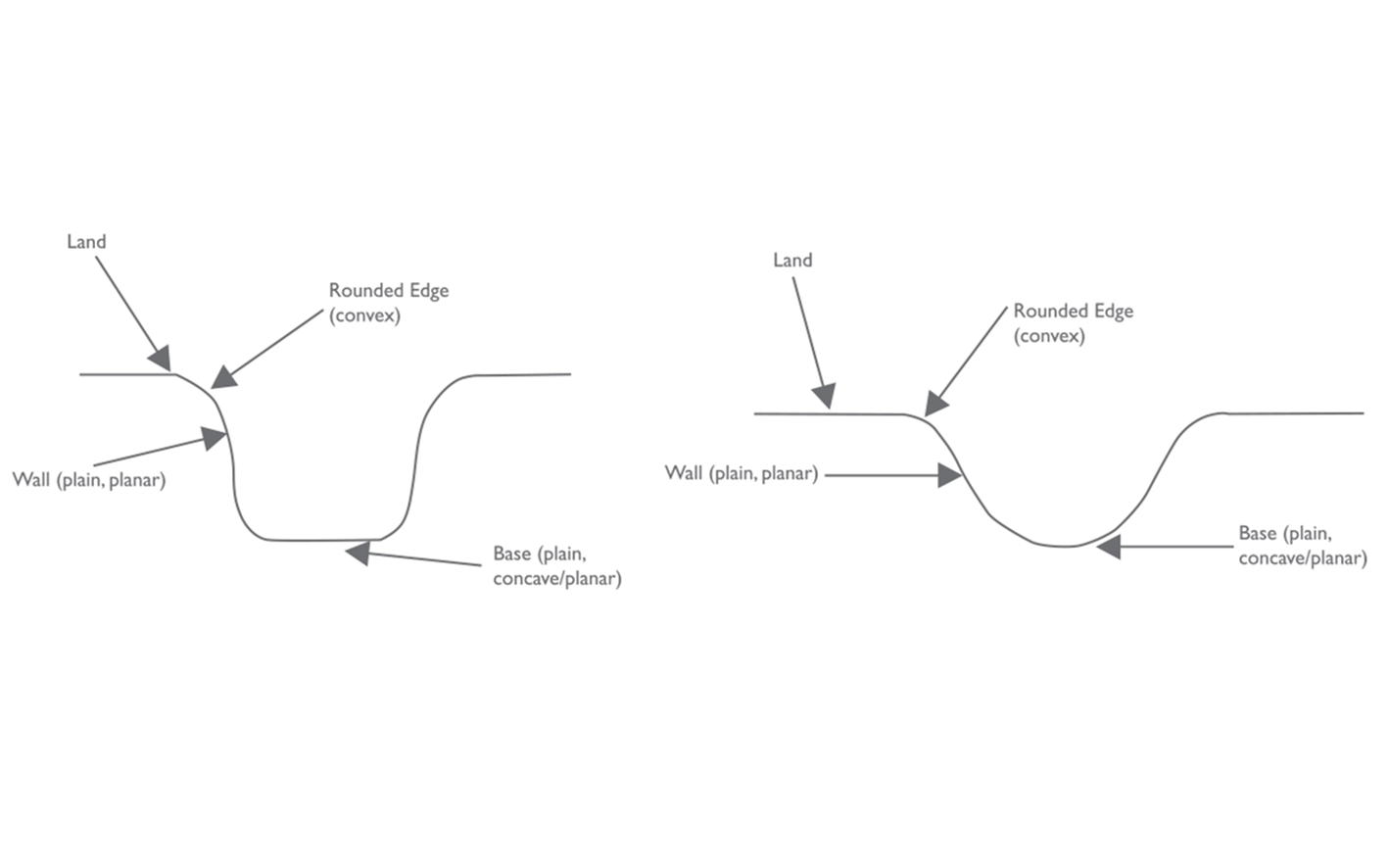Saltar para a secção
Imprimir secção
CSupplementary Paper: 2010 Club Face Markings
C
Supplementary Paper: 2010 Club Face Markings
C
Supplementary Paper: 2010 Club Face Markings
1.1
2010 Club Face Marking
1.1a
New Specifications and Interpretations
From 1 January 2010, the Rules on club face markings include the following three additional specifications for clubs other than driving clubs and putters:
- The total cross-sectional area of a groove divided by the groove pitch (width plus separation) will be limited to 0.0030 square inches per inch (0.0762 mm2/mm);
- Groove edge sharpness will be required to be substantially in the form of a round having an effective minimum radius of 0.010 inches (0.254 mm). This limit will only apply to clubs with lofts of 25 degrees and above.
- Grooves will be required to be plain.
1.1b
Interpretation of a Plain Groove
- The groove starts where there is a significant departure from the plane of the face and this is joined to the side (or wall) of the groove via the edge. The side (or wall) continues to the base of the groove.
- The sides (or walls) of the groove must be substantially plain and planar. This disallows features such as bends, indentations in or protrusions from the wall.
- The base of the groove must also be substantially plain and join the two opposing sides (or walls) of the groove using a concave shape or a plane.
- Groove edges must be a convex curve and must not include serrations, gear teeth or other similar features.
- For clubs with lofts less than 25 degrees, where it is difficult to determine whether a groove violates either the edge requirement or the plain wall requirement, the groove will be deemed to meet the plain wall requirement.
Permissible groove geometries

1.1c
Determining the Status of Markings in the Impact Area Against 2010 Specifications
Full details of the procedure for measuring club face markings and determining their status against the 2010 specifications can be found on The R&A’s website. However, a summary is as follows:
The following algorithm will be used to determine the conformance status of clubs to the new Rules on impact area markings from 1 January 2010, regardless of what method has been used to obtain the measurements. Within the following procedure, the inherent difficulty of manufacturing grooves has been taken into consideration. However, it should be stressed that clubs must be designed and manufactured with the intent of conforming to the Rules.
Note that, for all dimensional limitations described below, each measurement will be based on a confidence level of at least 95% confidence as determined by standard Gauge R&R procedures. All measurements will include appropriate outlier controls to ensure that rulings are not based on spurious or anomalous data. Improvements to measurement techniques and consequently the associated measurement tolerances may be introduced at any time.
(i) Groove Width
Rounding of groove edges shall be in the form of a radius having an effective radius not less than 0.010” (0.254 mm) as determined by the two circles method, nor greater than 0.020” (0.508 mm). The following two criteria are used for determining conformance:
- If 50% or more of the measured groove widths exceed 0.035” (0.889 mm) then the club is non-conforming.
- If any single measured groove width exceeds 0.037” (0.940 mm) then the club is non-conforming.
- If 50% or more of the measured groove depths exceed 0.020” (0.508 mm) then the club is non-conforming.
- If any single measured groove depth exceeds 0.022” (0.559 mm) then the club is non-conforming.
- If 50% or more of the measured groove separations are less than three times the maximum adjacent measured groove width then the club is non-conforming.
- If any single measured groove separation is less than three times the maximum adjacent measured groove width minus 0.008” (0.203 mm) then the club is non-conforming.
- If 50% or more of the measured groove separations are less than 0.075” (1.905 mm) then the club is non-conforming.
- If any single measured groove separation is less than 0.073” (1.854 mm) then the club is non-conforming.
- The range of measured groove widths cannot exceed 0.010” (0.254 mm).
- The range of measured groove depths cannot exceed 0.010” (0.254 mm).
- If 50% or more of the measured values of A/(W+S) are greater than 0.0030 square inches per inch (0.0762 mm2/mm) then the club is non-conforming.
- If the measured value of A/(W+S) value for any single groove is greater than 0.0032 square inches per inch (0.0813 mm2/mm) then the club is non-conforming.
Rounding of groove edges shall be in the form of a radius having an effective radius not less than 0.010” (0.254 mm) as determined by the two circles method, nor greater than 0.020” (0.508 mm). The following two criteria are used for determining conformance:
- If 50% or more of the upper groove edges or 50% or more of the lower groove edges fail the two circles method subject to a 10 degree angular allowance, then the club is non-conforming.
- If any single groove edge protrudes more than 0.0003” (0.0076 mm) outside the outer circle, then the club is non-conforming.
- If 50% or more of the punch mark edges fail the two circles method subject to a 10 degree angular allowance, then the club is non-conforming.
- If any single punch mark edge protrudes more than 0.0003” (0.0076 mm) outside the outer circle, then the club is non-conforming.